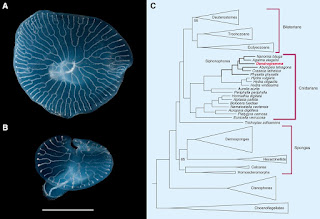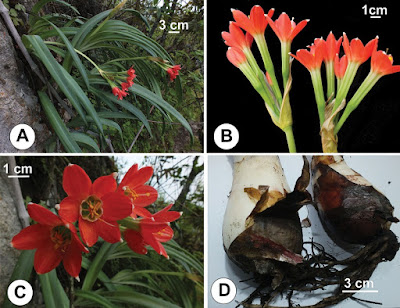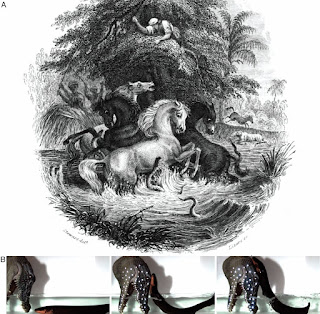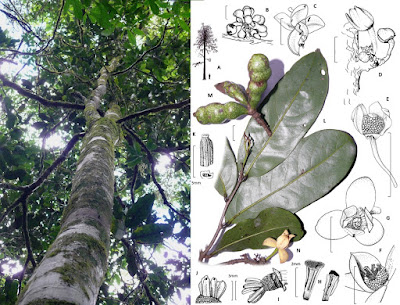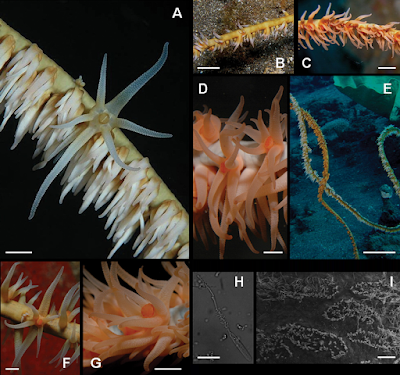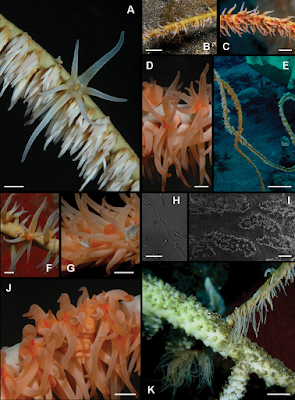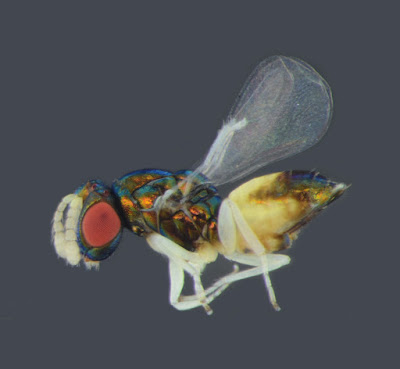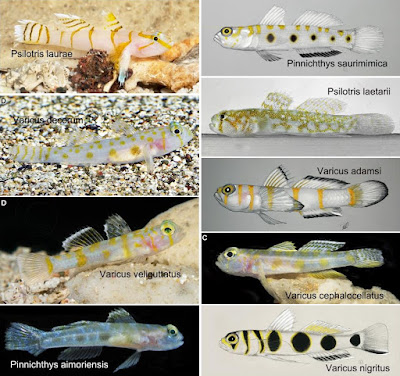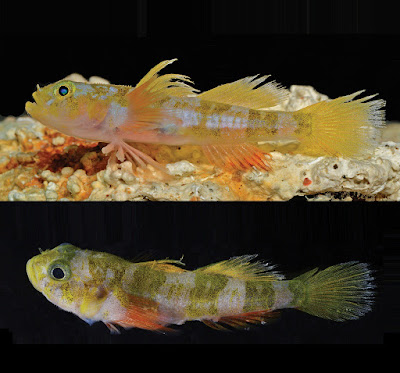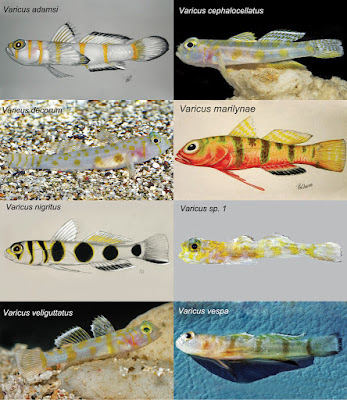[Most Recent Entries] [Calendar View]
Friday, June 10th, 2016
| Time | Event | ||||
| 12:22a | [Cnidaria • 2016] Dendrogramma is A Siphonophore Summary Dendrogramma was the iconic deep-sea animal of 2014, voted among the top-ten new species described that year . The two species described are mushroom shaped animals, diploblastic, with an apparent gastrovascular system that extends from the base of the stalk to bifurcating canals that radiate through the flat disc . The authors could not assign the new genus to any known animal group with certainty, leading to numerous media reports that it belonged to an entirely new phylum. Here we use phylogenomic data from newly collected specimens to show that Dendrogramma is a cnidarian, specifically a benthic siphonophore in the family Rhodaliidae. Although an entire Dendrogramma colony has not been found, we hypothesise that the mushroom-like bodies are bracts, possibly used to aid buoyancy or as defensive appendages to protect feeding gastrozooids or gonads. Timothy D. O’Hara, Andrew F. Hugall, Hugh MacIntosh, Kate M. Naughton, Alan Williams and Adnan Moussalli. 2016. Dendrogramma is A Siphonophore. Current Biology. 26(11); pR457–R458. DOI: 10.1016/j.cub.2016.04.051 | ||||
| 12:23a | [Botany • 2016] Clinanthus milagroanthus • A New Species of Clinanthus from northern Peru (Asparagales, Amaryllidaceae, Amarylloideae, Clinantheae)
Abstract Clinanthus milagroanthus S. Leiva & Meerow, sp. nov. is described from the Department of La Libertad in Peru. The new species is most closely related to C. mirabilis (Ravenna) Meerow, with further affinities to C. viridiflorus (R. & P.) Meerow. It can be distinguished from C. mirabilis by its wider leaves, the much more brightly colored and wide spreading limb, and the much lighter colored perigone tube (yellowish green vs. dark green in C. mirabilis). A conspicuous bulge just proximal to the midpoint of the tube is a unique character of the new species. Keywords: Geophyte, Andes, Clinantheae, new species, taxonomy Vernacular name: “cebolla de peña.” Etymology: The specific epithet honors Ms. Milagros Leiva Salinas, a student of Human Medicine, who has been studying the phytochemistry of Peruvian genera of Amaryllidaceae. Segundo Leiva and Alan W. Meerow. 2016. A New Species of Clinanthus from northern Peru (Asparagales, Amaryllidaceae, Amarylloideae, Clinantheae). PhytoKeys. 63: 99-106. DOI: 10.3897/phytokeys.63.8895 Resumen: Clinanthus milagroanthus S. Leiva & Meerow, sp. nov. se describe desde el Departamento de La Libertad, Perú. La nueva especie es más estrechamente relacionada con C. mirabilis (Ravenna) Meerow, con adicionales afinidades con C. viridiflorus (R. & P.) Meerow. Se puede distinguir de C. mirabilis por sus hojas más anchas, el limbo mucho más amplio de colores brillantes, y el color de tubo perigonio mucho más claro (color amarillento vs. verde verde oscuro en C. mirabilis). Una protuberancia visible casi proximal al punto medio del tubo es un carácter único de la nueva especie. | ||||
| 1:40a | [Ichthyology / Behaviour • 2016] Leaping Eels Electrify Threats, Supporting Humboldt’s Account of A Battle with Horses Significance Electric eels are shown to leap from the water to directly electrify threats. This shocking behavior likely allows electric eels to defend themselves during the Amazonian dry season, when they may be found in small pools and in danger of predation. The results support Alexander von Humboldt’s story of electric eels attacking horses that had been herded into a muddy pool during the dry season in 1800. The finding highlights sophisticated behaviors that have evolved in concert with the eel’s powerful electrical organs. Abstract In March 1800, Alexander von Humboldt observed the extraordinary spectacle of native fisherman collecting electric eels (Electrophorus electricus) by “fishing with horses” [von Humboldt A (1807) Ann Phys 25:34–43]. The strategy was to herd horses into a pool containing electric eels, provoking the eels to attack by pressing themselves against the horses while discharging. Once the eels were exhausted, they could be safely collected. This legendary tale of South American adventures helped propel Humboldt to fame and has been recounted and illustrated in many publications, but subsequent investigators have been skeptical, and no similar eel behavior has been reported in more than 200 years. Here I report a defensive eel behavior that supports Humboldt’s account. The behavior consists of an approach and leap out of the water during which the eel presses its chin against a threatening conductor while discharging high-voltage volleys. The effect is to short-circuit the electric organ through the threat, with increasing power diverted to the threat as the eel attains greater height during the leap. Measurement of voltages and current during the behavior, and assessment of the equivalent circuit, reveal the effectiveness of the behavior and the basis for its natural selection. Keywords: evolution; behavior; Humboldt; electroreception; neuroethology Kenneth C. Catania. 2016. Leaping Eels Electrify Threats, Supporting Humboldt’s Account of A Battle with Horses. PNAS. DOI: 10.1073/pnas.1604009113 Video: Jumping electric eels pack more zap http://www.sciencemag.org/news/2016/06/v Electric eels make leaping attacks: Research confirms 200-year-old story by Alexander von Humboldt https://www.sciencedaily.com/releases/20 | ||||
| 4:23a | [Botany • 2016] Polyceratocarpus askhambryan-iringae • A New Species in the Tree Genus Polyceratocarpus (Annonaceae) from the Udzungwa Mountains of Tanzania
Abstract Polyceratocarpus askhambryan-iringae, an endemic tree species of Annonaceae from the Udzungwa Mountains of Tanzania, is described and illustrated. The new species is identified as a member of the genus Polyceratocarpus by the combination of staminate and bisexual flowers, axillary inflorescences, subequal outer and inner petals, and multi-seeded monocarps with pitted seeds. From P. scheffleri, with which it has previously been confused, it differs in the longer pedicels, smaller and thinner petals, shorter bracts, and by generally smaller, less curved monocarps that have a clear stipe and usually have fewer seeds. Because P. askhambryan-iringae has a restricted extent of occurrence, area of occupancy, and ongoing degradation of its forest habitat, we recommend classification of it as Endangered (EN) on the IUCN Red List. Keywords: East Africa, Eastern Arc, endemism, Ndundulu, Polyceratocarpus
Andrew R. Marshall, Thomas L.P. Couvreur, Abigail L. Summers, Nicolas J. Deere, W.R. Quentin Luke, Henry J. Ndangalasi, Sue Sparrow and David M. Johnson. 2016. A New Species in the Tree Genus Polyceratocarpus (Annonaceae) from the Udzungwa Mountains of Tanzania. PhytoKeys. 63: 63-76. DOI: 10.3897/phytokeys.63.6262 Schoolkids name a new tree species from Tanzania while fundraising for tropical forests http://scienmag.com/schoolkids-name-a-ne | ||||
| 4:32a | [Cnidaria • 2009] Pseudocirrhipathes mapia • A New Genus of Whip Black Corals (Anthozoa: Hexacorallia: Antipathidae) from the Indo‐Pacific
Abstract The new species, Pseudocirrhipathes mapia, is herein described from specimens coming from the coral reefs of the Bunaken Marine Park (North Sulawesi, Indonesia). The species is characterized by an unbranched thin corallum up to 1 m high (maximum basal thickness 4 mm), with large polyps arranged irregularly on one side of the stem, and by tentacles that are not completely contractile. The skeleton shows an array of spine morphologies along the stem, although most are typically verticillated in the apical section and highly tuberculated in the central portion. The study of its cnidome revealed the presence of an extremely long basitrich isorhiza. The morphological analysis has been coupled with a molecular study of the rDNA ITS sequences confirming the existence of the new genus Pseudocirrhipathes and its inclusion, together with the genus Allopathes, in a separate clade related to the Antipathidae. Keywords: New species, ITS rDNA, basitrich isorhiza, morphology, Indonesia Genus Pseudocirrhipathes Bo and Bavestrello n. gen. Pseudocirrhipathes mapia Bo and Bavestrello n. spec. Cirripathes? sp. Thomson and Simpson, 1905 Cirripathes rumphii van Pesch, 1910 (pro parte) Eucirripathes rumphii van Pesch, 1914 (pro parte) Diagnosis: Monopodial corallum, not ramified nor pinnulated, straight or slightly coiled in the distal portion. The stem of the colony is thin, flexible and characterized by a very large hollow central canal, especially in the apical portion. Spines triangular or sub-triangular, mainly perpendicular to the axis, with numerous rounded tubercles at least in a portion of the stem; arranged in verticils at the apex of the colony. Polyps large, 1–4 mm in transverse diameter, with long sagittal tentacles (up to 7 mm), not completely contractile, with 10 mesenteries; arranged in irregular rows along the stem, and leaving free most of the abpolypar side. Typical large isorhizae are present.
Remarks: Pseudocirrhipathes is the third genus of black coral, together with Cirrhipathes and Stichopathes, characterized by a monopodial, unbranched and unpinnulated corallum. It differs from Stichopathes by having irregularly arranged polyps and from Cirrhipathes by having tuberculated verticillated spines and, as observed in situ, tentacles unable to completely contract (Figure 2). The genus Allopathes is always distinguishable due to the shape of the colonies, which are composed of several elongated stems arising from a short trunk-like base or primary stem (Opresko 2003). Etymology: The generic name is derived from the words ‘‘pseudo’’ (false) and ‘‘cirrhipathes’’ in reference to the apparent similarity of this genus to Cirrhipathes. [Note: The original genus name Cirrhipathes was later cited as Cirripathes; however, this is considered an incorrect emendation (see Opresko & Cairns 1994).] The specific name refers to the Indonesian term ‘‘mapia’’ meaning ‘‘beautiful’’. Mapia is also the name of the dive site where it was collected for the first time and where the population shows its highest density. Distribution: Indonesian Archipelago (Bunaken Marine Park, Ambon, Bali, Timor, Flores), Ceylon. M. Bo , M. Barucca , M. A. Biscotti , A. Canapa , H. F. N. Lapian , E. Olmo and G. Bavestrello. 2009. Description of Pseudocirrhipathes (Cnidaria: Anthozoa: Hexacorallia: Antipathidae), A New Genus of whip black corals from the Indo‐Pacific. Italian Journal of Zoology. 76(4); 392-402. DOI: 10.1080/11250000802684104 | ||||
| 10:01a | [Entomology • 2015] Three New Species of Dzhanokmenia (Hymenoptera: Eulophidae) from Xinjiang Uyghur Autonomous Region of China; D. muleica, D. karamayica & D. gobica
Abstract Three new species of Dzhanokmenia Kostjukov (Hymenoptera: Eulophidae: Tetrastichinae), D. muleica Li, Wang & Hu sp. n., D. karamayica Li, Wang & Zhu sp. n. and D. gobica Li, Wang & Zhu sp. n. from Xinjiang Uyghur Autonomous Region of China are described and illustrated. A key to all known species of the genus is provided. Keywords: Hymenoptera, Chalcidoidea, taxonomy, desert, Junggar Basin, Palearctic  Qin Li, Chao Wang, Hong-Ying Hu, Viktor V. Kostjukov, John La Salle and Chao-Dong Zhu. 2016. Descriptions of Three New Species of Dzhanokmenia (Hymenoptera: Eulophidae) from China. Zootaxa. 4121(4) DOI: 10.11646/zootaxa.4121.4.5 | ||||
| 1:47p | [Ichthyology • 2016] Molecular Phylogeny, Analysis of Character Evolution, and Submersible Collections Enable A New Classification of A Diverse Group of Gobies (Gobiidae: Nes Subgroup), including Nine New Species and Four New Genera
The Nes subgroup of the Gobiosomatini (Teleostei: Gobiiformes: Gobiidae) is an ecologically diverse clade of fishes endemic to the tropical western Atlantic and eastern Pacific oceans. It has been suggested that morphological characters in gobies tend to evolve via reduction and loss associated with miniaturization, and this, coupled with the parallel evolution of adaptations to similar microhabitats, may lead to homoplasy and ultimately obscure our ability to discern phylogenetic relationships using morphological characters alone. This may be particularly true for the Nes subgroup of gobies, where several genera that are diagnosed by ‘reductive characters’ have been shown to be polyphyletic. Here we present the most comprehensive phylogeny to date of the Nes subgroup using mitochondrial and nuclear sequence data. We then evaluate the congruence between the distribution of morphological characters and our molecular tree using maximum-likelihood ancestral state reconstruction, and test for phylogenetic signal in characters using Pagel's λ tree transformations (Nature, 401, 1999 and 877). Our results indicate that all of the characters previously used to diagnose genera of the Nes subgroup display some degree of homoplasy with respect to our molecular tree; however, many characters display considerable phylogenetic signal and thus may be useful in diagnosing genera when used in combination with other characters. We present a new classification for the group in which all genera are monophyletic and in most cases diagnosed by combinations of morphological characters. The new classification includes four new genera and nine new species described here, many of which were collected from rarely sampled deep Caribbean reefs using manned submersibles. The group now contains 38 species in the genera Carrigobius gen. nov., Chriolepis, Eleotrica, Gobulus, Gymneleotris, Nes, Paedovaricus gen. nov., Pinnichthys gen. nov., Psilotris gen. nov., and Varicus. Lastly, we provide a key to all named species of the Nes subgroup along with photographs and illustrations to aid in identification. Keywords: ancestral state reconstruction; Caribbean; coral reef fish; deep reefs; gobies; Gobiidae; systematics Systematics • Carrigobius Van Tassell, Tornabene & Gilmore gen. nov. Type species: Carrigobius amblyrhyncus (Smith & Baldwin, 1999: 434, Figs 1-3, described as Psilotris amblyrhyncus) Etymology: The name Carrigobius is formed from the Latin gobius (goby or gudgeon) and Carrie, in reference to Carrie-Bow Cay, Belize, home of the Smithsonian Institution's field station, where many specimens of Carrigobius amblyrhynchus were collected. • Chriolepis Gilbert, 1892 Type Species: Chriolepis minutilla Gilbert, 1892 (Original Spelling Chriolepis minutillus), by Monotypy • Pycnomma Rutter, 1904 Type Species: Pycnomma semisquamatum Rutter, 1904, by monotypy • Cryptopsilotris Van Tassell, Tornabene & Gilmore gen. nov. Type Species: Cryptopsilotris batrachodes (Böhlke, 1963: 6, fig. 2, Described as Psilotris batrachodes) Etymology: The genus name is formed from ‘Psilotris’, the genus the type species was formerly classified under, and the root ‘crypto-’, which is taken from the Greek ‘kruptos’ meaning hidden. The name is in reference to the cryptic coloration of the type species. • Eleotrica Ginsburg, 1933 Type Species: Eleotrica cableae Ginsburg, 1933 (p. 10, by Original Designation) • Gobulus Ginsburg, 1933 Type Species: Gobulus crescentalis (Gilbert, 1892) (Ginsburg, 1933: 12, by Original Designation) • Gymneleotris Bleeker, 1874 Type Species: Gymneleotris seminudus (Günther, 1864: 304, Described as Eleotris seminudus Günther, 1864, by Original Designation) • Nes Ginsburg, 1933 Type Species: Nes longus (Nichols, 1914) (Ginsburg, 1933: 25, Described as Gobiosoma longum Nichols, 1914, by Original Designation; Proposed as a Subgenus of Gobiosoma) • Paedovaricus Van Tassell, Tornabene & Gilmore gen. nov. Type Species: Paedovaricus imswe (Greenfield, 1981: 269, Described as Varicus imswe) Etymology: The genus name Paedovaricus is formed from the root ‘paed-’ (the English spelling of the Greek root ‘ped-’, meaning ‘child’) and Varicus. The name is in reference to the small size of the type species Paedovaricus imswe and its general similarity to the genus Varicus. • Pinnichthys Van Tassell, Tornabene & Gilmore gen. nov. Type Species: Pinnichthys aimoriensis Van Tassell, Tornabene & Gilmore sp. nov. Etymology: The name Pinnichthys is formed from the roots pinna (Latin, feminine; fin) and ichthys (Latinized form of the Greek acronym ichthus; fish). The name is given in reference to the high number of fin rays in the second dorsal fin and anal fin of all species in the genus. Pinnichthys aimoriensis Van Tassell & Tornabene sp. nov. | Thiony's Goby Habitat: Collected from the seafloor near the Peroá natural gas platform. The substrate was predominately rhodoliths and other calcareous substrate. Distribution: Known only from the margin of the continental shelf of Brazil off Espírito Santo. Etymology: The species epithet aimoriensis is an adjective formed from the proper noun Aimorés, an indigenous warrior people from the lands now belonging to the Brazilian states Espírito Santo, Bahia, and Minas Gerais. The Aimorés people were virtually extirpated by European settlers during the Aimorés War (1555–1673), and much of their native forest has been replaced by agriculture. The type locality for Pinnichthys aimoriensis gen. et sp. nov. is adjacent to the Peroá natural gas platform, and the nearby coastal region is facing rapid development from the petroleum industry and mining of rhodolith beds (carbonates) for agriculture, and may be under threat of losing biodiversity before it can be adequately studied and described. This situation is analogous to the loss of Aimorés culture and the forest biodiversity that inhabited their native lands of the Central Brazilian coast. Pinnichthys saurimimica Gilmore, Van Tassell & Tornabene sp. nov. | Lizardfish Goby Habitat: Holotype was collected on a calcareous sand and dead Halimeda spp. algal rubble zone, with scattered shallow calcareous rock ledges. Distribution: Known only from San Salvador, Bahamas, the type locality. Etymology: The name saurimimica is derived from ‘saurus’, a genus of lizard fish and the Greek ‘mimic’, as the colour pattern closely resembles that of a lizard fish. • Psilotris Ginsburg, 1953 Type Species: Psilotris alepis Ginsburg, 1953 (by Original Designation) Psilotris laetarii Van Tassell & Young sp. nov. | Burrow Splitfin Goby Distribution: Known only from the type series collected off the south shore of Marathon, Florida. Etymology: Named in honor of Heath Jens Laetari, 28 years old, Vice President of Dive Operations, Partner & Acquisition Manager for Dynasty Marine, who was lost at sea on 14 September 2006, doing what he loved to do. Psilotris laurae Van Tassell, Tornabene & Baldwin sp. nov. | Thin-barred Goby Habitat: The only known specimen was found inside a glass bottle collected along a sandy slope between 114 and 137 m depth. There is no additional information on the natural microhabitat of this species. Distribution: Known only from the type location off Bonaire. Etymology: Named after Laura Albini, wife of Adriaan ‘Dutch’ Schrier, the owner of Substation Curaçao, through whose efforts new, tropical, deep-water species are being discovered. Laura has generously fed and hosted numerous researchers during their visits to Curaçao. • Varicus Robins & Böhlke, 1961 Type Species: Varicus bucca Robins & Böhlke, 1961 (p. 47, Figs 1-3, by Original Designation) Varicus adamsi Gilmore, Van Tassell & Tornabene sp. nov. | Twilight Goby Distribution: Known only from the western shore of San Salvador, Bahamas and from Tobago. Etymology: Named for the late famed research submersible pilot, Mr. Michael Adams, who painstakingly captured both Bahamas specimens during a 30–45 min chase using a 26 ton submarine (JSL – II) in simultaneous multiple thrust, multi-directional mode to allow this description. Mr. Adams was one of the five original research submersible pilots within the United States. Varicus cephalocellatus sp. nov., Gilmore, Van Tassell, and Baldwin | Ocellated Splitfin Goby Distribution: All specimens are known from southern Lesser Antilles, St. Vincent, Barbados and Bonaire. Etymology: Named for series of ocelli on head extending from mouth diagonally to nape. Varicus decorum sp. nov., Van Tassell, Baldwin and Tornabene | Decorated Splitfin Goby Habitat: This species has been collected from sand habitats with scattered rocks and calcareous rubble, from depths of 99 m to at least 197 m, and possibly 251 m. It has been observed perching on open sand and retreating into crevices when disturbed. Distribution: Known only from deep reefs off Curaçao. Etymology: The specific epithet decorum is Latin for “decorated”, “adorned”, “beautiful” or “elegant” and is in reference to the beautiful round yellow markings on the dorsal surface of the body. Varicus nigritus sp. nov., Gilmore, Van Tassell, and Baldwin | Banded Splitfin Goby Habitat: The holotype was captured off Rocky Point along the northwest shore of San Salvador, Bahama Islands on a steep rocky slope (45° slope) with thin and sparse calcareous Halimeda rubble layer mixed with scattered flat rock outcroppings, hard rock unlayment and scattered rock boulders 1–30 m in diameter. Distribution: A single specimen captured at 243.8 m off San Salvador, Bahama Islands. Etymology: The epithet nigritus, Latin for “black”, is given in reference to the diagnostic dark black wide bars on the trunk of this species. Varicus veliguttatus sp. nov., Van Tassell, Baldwin and Gilmore | Spotted-sail Goby Habitat: In the Bahamas this species was collected from oolite sedimentary rock at 287.6 m depth. In Curaçao this species was collected at depths between 152 m and 225 m, over sand habitats with rubble, gravel and shells. Distribution: Known from San Salvador, Bahamas, Curaçao, and Tobago. Etymology: The specific epithet veliguttatus is formed from the Latin roots veli- (sail) and guttatus (spotted or speckled). The scientific name and common name refer to the scattered black markings on the first dorsal fin. Summary of Systematic Changes Based on our combined analysis of molecular data from mtDNA, nuclear genes, and morphological characters, we have made the following changes in the classification of the Nes subgroup in order to render all groups monophyletic (see Table 2). We synonymize the genus Pycnomma with Chriolepis. Two Atlantic species previously belonging to Chriolepis (C. vespa and C. benthonis) are now reassigned to the genus Varicus, which now also contains five new species described here (Varicus adamsi sp. nov., Varicus cephalocellatus sp. nov., Varicus decorum sp. nov., Varicus nigritus sp. nov., Varicus veliguttatus sp. nov.). The genus Pinnichthys is erected for the new species Pinnichthys aimoriensis gen. et sp. nov., and also contains three other species formerly included in Chriolepis (C. atrimela, C. bilix, C. prolata). The new genus Paedovaricus is erected for Paedovaricus imswe (formerly Varicus imswe), and the new genus Carrigobius is erected for Carrigobius amblyrhynchus (formerly Psilotris amblyrhynchus). Chriolepis fisheri is considered incertae sedis, as its phylogenetic position is either sister to Pinnichthys, or nested within Psilotris. The latter genus now includes the two new species P. laetarii sp. nov. and P. laurae sp. nov. Luke Tornabene, James L. Van Tassell, Richard G. Gilmore, David Ross Robertson, Forrest Young and Carole C. Baldwin. 2016. Molecular Phylogeny, Analysis of Character Evolution, and Submersible Collections Enable A New Classification of A Diverse Group of Gobies (Teleostei: Gobiidae: Nes subgroup), including Nine New Species and Four New Genera. Zoological Journal of the Linnean Society. DOI: 10.1111/zoj.12394 Nine new species of Goby Fish are discovered http://curacaochronicle.com/main/nine-ne | ||||
| 2:01p | [Ichthyology • 2016] Varicus lacerta • A New Species of Goby (Gobiidae, Gobiosomatini, Nes Subgroup) from A Mesophotic Reef in the southern Caribbean
Abstract We describe a new species of goby, Varicus lacerta sp. n., which was collected from a mesophotic reef at Curacao, southern Caribbean. The new species is the tenth species of Varicus, all of which occur below traditional SCUBA depths in the wider Caribbean area. Its placement in the genus Varicus is supported by a molecular phylogenetic analysis of three nuclear genes and the mitochondrial gene cytochrome b. In addition, the new species has one anal-fin pterygiophore inserted anterior to the first haemal spine, which distinguishes Varicus species from most species in the closely related and morphologically similar genus Psilotris. Varicus lacerta sp. n. is distinguished from all other named species of Varicus by the absence of scales, having highly branched, feather-like pelvic-fin rays, and in its live coloration. We provide the cytochrome c oxidase I DNA barcode of the holotype and compare color patterns of all species of Varicus and Psilotris for which color photographs or illustrations are available. This study is one of several recent studies demonstrating the utility of manned submersibles in exploring the diversity of poorly studied but species-rich deep-reef habitats. Keywords: Systematics, molecular phylogeny, deep reefs, submersible, Curaçao, Psilotris
Diagnosis: Second dorsal fin I,9; anal fin I,7; pectoral fin 18; no scales; cephalic papillae rows 5s and 5i connected, forming a single row; pelvic rays 1-4 highly branched and feather-like; one anal-fin pterygiophore inserted anterior to first haemal spine; body with five broad, indistinct, dark vertical bands washed with bright yellow in life; pelvic, pectoral and anal fins yellow-orange in life, dorsal, anal, and caudal fins yellow with faint orange tint. Habitat: The only known specimen was collected at 129–143 m. Quinaldine was dispersed around a yellow sponge (~20 cm tall) tentatively identified from videos by Allen Collins (National Marine Fisheries Service) as Dactylocalyx pumiceus, situated on a rocky outcropping along the deep-reef slope. After approximately 20 seconds the stunned fish emerged from a space in the rocky substrate at the base of the sponge and was captured. It is unclear whether the fish was originally in direct association with the sponge itself or was instead sheltering in spaces within the rock. Video of the capture taken from a high-definition video camera mounted on the outside of the Curasub is available online (youtu.be/UvxJEi-vER0). Subsequent collections targeting similar sponges and rocky substrates within this depth range at the type locality have not yielded additional specimens. Distribution: Known only from the type location in Curaçao. Etymology: The specific epithet ‘lacerta’ (Latin for ‘lizard’) is in reference to the reptilian or saurian appearance of this species, as indicated by its bright yellow and orange coloration, green eyes, disproportionately large head possessing raised ridges of papilla, and multiple rows of recurved canine teeth in each jaw. The common name Godzilla goby (gobio Godzilla in Spanish) refers to the radioactive reptilian monster from the sea that appeared in Japanese science-fiction films as Gojira, renamed Godzilla in subsequent English-language films. Luke Tornabene, D. Ross Robertson and Carole C. Baldwin. 2016. Varicus lacerta, A New Species of Goby (Teleostei, Gobiidae, Gobiosomatini, Nes Subgroup) from A Mesophotic Reef in the southern Caribbean. ZooKeys. 596: 143-156. DOI: 10.3897/zookeys.596.8217 |
| << Previous Day |
2016/06/10 [Calendar] |
Next Day >> |

